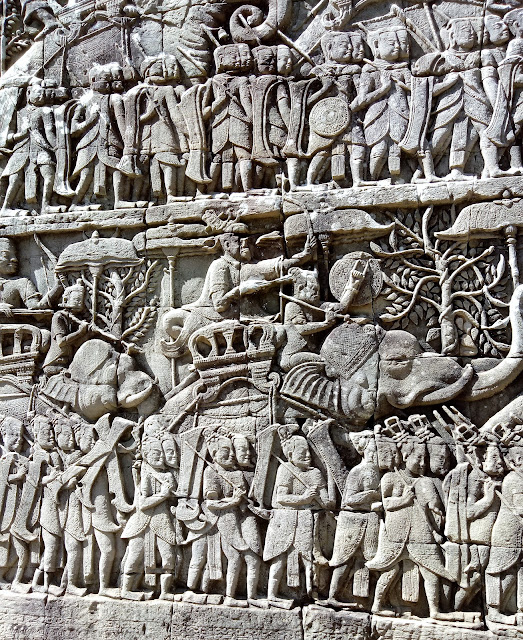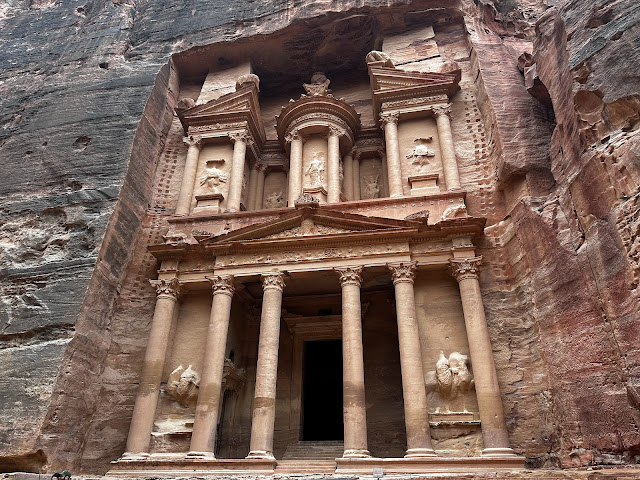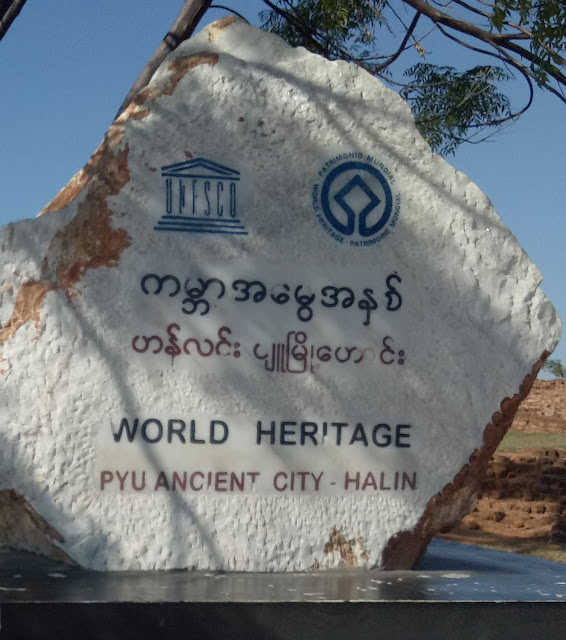Angkor Thom : The last capital of the Khmer Empire
Angkor Thom (alternatively referred to as "Nokor Thom" in Khmer, which translates to “Great City”) was established by “King Jayavarman VII” (who reigned from 1181 CE to 1218 CE) during the late 12th Century CE. It was the last capital of the Khmer Empire. Covering an area of approximately nine square kilometres, Angkor Thom contains several monuments established by Jayavarman VII himself as well as his predecessors and successors. Some of the best-known monuments are the Bayon temple, the Terrace of the Elephants and the Terrace of the Leper King.
City gates and entry towers
City gates of Angkor Thom are some of the most creative and photographed. Each gate leads to a sandstone tower which is approximately 23 meters in height. Each tower is crowned with four heads facing each of the cardinal directions. These heads may represent King Jayavarman VII himself, the bodhisattva Avalokiteśvara or the guardians of the empire’s cardinal points.
 |
| The entry tower at the southern gate of Angkor Thom |
A long causeway leads to each entry tower. These causeways are flanked by two rows of 54 stone figures on each side. The figures on the right hand side are considered to depict demons or Asuras, whereas the figures on the left hand side are considered to depict gods or Devas. Each row appears to be holding a Naga in what appears to be a tug-of-war.
 |
| The Asuras depicted on the right hand side of the causeway at the southern gate of Angkor Thom |
 |
| The Naga head at the start of the left hand side of the causeway at the southern gate of Angkor Thom |
In summary, the causeways leading to the entry towers of Angkor Thom appears to be depicting the Churning of the Sea of Milk (referred to as the Samudra Manthana in the "Bhagavata Purana", in the "Mahabharata" and in the "Vishnu Purana), which is a legend from Hindu mythology. It explains the origin of Amrita, the nectar of immortality. As per legend, under the direction of god Vishnu, Devas and Asuras churned the sea of milk using the serpent king (Nagaraja) Vasuki as the churning rope and “Mount Mandara” as the churning rod. The events of the Churning of the Sea of Milk is also depicted in great detail within the galleries of Angkor Wat.
The Bayon Temple
The Bayon temple which stands at the center of Angkor Thom, was the last state temple to be built in Angkor and the only state temple to be built primarily dedicated to Mahayana Buddhism. Bayon is considered to have been built during the reign of King Jayavarman VII who was a devotee of Mahayana Buddhism. Following the death of the king, the later rulers modified the temple in accordance with their religious beliefs. King Jayavarman VII was succeeded by “King Indravarman II” who was a Buddhist. However, the next ruler “King Jayavarman VIII” reverted to Hinduism and only during the reign of his successor “King Indravarman III” did Theravada Buddhism become the state religion of the empire. Today, Theravada Buddhism remains the state religion of Cambodia and is followed by more than 95% of the population.
 |
| Bayon temple |
The original name for Bayon was "Jayagiri" which translates to "Victory mountain". The French called the site, Banyan Temple during their occupation due to its’ significance to and relationship with Buddhism. Later mispronunciations by the locals during renovation has resulted in "Banyan" being converted to "Bayon": the name by which the temple is recognized today.
Oriented towards the east, the most notable feature of the monument is the estimated 216 massive faces on the temple towers. The similarity of these faces to other representations of King Jayavarman VII has resulted in some scholars concluding that the faces depict the king himself, where as another school of thought is that the faces depict the bodhisattva Avalokiteśvara. The possibility that the king identified himself with the Buddha and the bodhisattva has also being considered. These faces are similar to the faces appearing on top of the entry towers of Angkor Thom.
Below are the images of some of these temple towers with massive faces:
The Bayon temple contains many well-preserved bas-reliefs which depicts historical events, daily life as well as mythological events. One of the most prominent depictions is the battle between the Khmers led by King Jayavarman VII and the Cham invaders of Vietnam which is believed to have taken place sometime around 1178 CE. Below are the images of some of these bas-reliefs:
Terrace of the Elephants
Another component of Angkor Thom is the Terrace of the Elephants. The terrace is believed to have been used by King Jayavarman VII as a platform from which to view his victorious returning armies. It is named after the carvings of elephants on its’ eastern face.
 |
| Terrace of the Elephants |
Some of the carvings which are still visible on the terrace contain elephants including three-headed elephants (likely to be “Airavata/Erawan” in Buddhist and Hindu mythology), garudas, lions as well as a five-headed horse.
 |
| One of the several carvings of the three-headed elephant "Airavata" at the Terrace of the Elephants |
 |
| The five headed horse carving at the Terrace of the Elephants |
 |
| Some of the carvings on the Terrace of the Elephants |
Terrace of the Leper King
The Terrace of the Leper King is located to the immediate north of the Terrace of Elephants. It is at the northwest corner of the Royal Square of Angkor Thom and is believed to have been constructed during the reign of King Jayavarman VII.
 |
| Terrace of the Leper King |
The name itself is a reference to the 15th century CE sculpture discovered at the site. The discoloration of the sculpture which was reminiscent of a person suffering from leprosy has resulted in the site being referred to as the "Terrace of the leper king".
There are several theories on who was depicted by the sculpture. One theory suggests that the statue is of the Angkorian King “Yasovarman I” (who reigned from 889 CE to 910 CE). Legends suggest that he was suffering from leprosy. There are some theories which also state that “Jayavarman VII” himself may have suffered from leprosy as well as his son and successor “Indravarman II” (who reigned from 1218 CE to 1243 CE). All these theories are based on the underlying assumption that the sculpture represented an actual ruler who was suffering from leprosy.
However, given the leper like appearance of the sculpture may be due erosion than by original design, it may not be depicting a ruler who suffered from leprosy to begin with. The original inscription of the statue was translated to be “Dharmaraja”. “Dharmaraja” was another name used for the Hindu God of death “Yama”. There are certain schools of thought which believe that most Khmer monuments served as funerary temples where the remains of the kings were deposited after cremation. If the royal crematorium was indeed located at the Terrace of the Leper King, the depiction of the god of death on the terrace itself would be far more logical as oppose to a king who suffered from leprosy.
Today, the original sculpture is displayed at the National Museum in Phnom Penh whereas a replica is placed at the actual site in Angkor Thom.
Similar to the Terrace of the Elephants, the walls of the Terrace of the Leper King is also decorated with many carvings which have survived to date. Below are the images of some of these sculptures:
Other monuments within Angkor Thom
Some other monuments within Angkor Thom include the Baphuon temple, the Khleangs, the Mangalartha temple, the Phimeanakas temple, Prasat Chrung, Prasat Suor Prat, Preah Palilay, Preah Pithu, Tep Pranam and the remains of the Royal Palace.
Abandonment of Angkor Thom
Historical records suggest that the Ayutthaya Kingdom of modern-day Thailand sacked Angkor Thom sometime around 1431 CE, led by King Borommarachathirat II (reigned from 1424 CE – 1448 CE). At the time, the Khmer empire was ruled by King Ponhea Yat who was also known as Barom Reachea II (reigned from 1405 CE – 1460 CE). The Khmers were forced to relocate first to Basan (Srey Santhor) and later to Chaktomuk (modern day Phnom Penh) marking the end of the Khmer Empire. Historical records suggest that even though the royal court briefly returned to Angkor during the the 16th Century CE, by the early 17th Century CE Angkor Thom was completely abandoned. At its peak, the city may have been inhabited by a population of over 100,000.


























Comments
Post a Comment